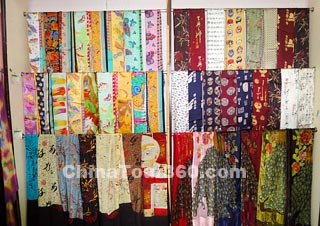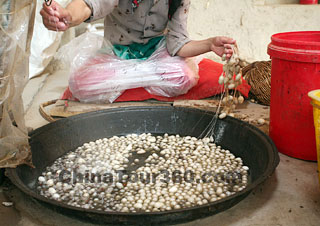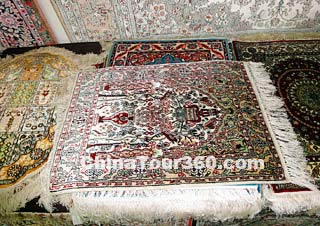During the Zhou Dynasty, a special administration was set up to manage sericulture and silk production. The famous Silk Road to the Middle East and Europe started under Zhang Qian. Under imperial order, he started his diplomatic mission to the west from 138 B.C. to 126 B.C. Gradually, sericulture and silk production techniques spread to other countries. Chinese silk was highly prized among the wealthy of ancient Rome. Chinese silk still enjoys its reputation for high quality through the world.
 |
| Silk Fabrics |
![]() Embroidery
Embroidery
Once the cloth had been weaved, embroidery was used to give the cloth its delicate, often brilliant patterns. The Four Renowned Embroideries of China were regional in their origin. Su embroidery originated from Jiangsu. Yue embroidery originated from Guangdong. Xiang embroidery originated from Hunan. Shu embroidery originated from Sichuan.
![]() Su Embroidery
Su Embroidery
Short for Suzhou, Su embroidery originated during the Northern Song Dynasty. According to historical records, Su embroidery became so popular during the Song Dynasty (960 - 1279) that people even named roads using words associated with silk and its embroidery. Nearly every family raised silkworms and embroidered. Su embroidery reached its peak during the Qing Dynasty (1644 - 1911).
Su embroidery has a wide range of themes. Its techniques include both single faced embroidery and unique double-faced embroidery that looks the same from either side. Basic features of Su embroidery are simple composition, clear theme, vivid image, and gentle color. In recent times, Su embroidery design has absorbed some western painting techniques.
![]() Yue Embroidery
Yue Embroidery
Yue embroidery is also called Cantonese because it is produced in Guangdong Province. It is said that Yue embroidery originated among a minority people during the middle to end of the Ming Dynasty (1368 - 1644). A variety of threat materials is used, including twisted peacock quill and hair from horse tails. Gold thread is used to establish contours for embroidering complicated patterns. Bright in color, Yue embroidery usually displays such themes as A Hundred Birds Displaying Homage, the Chinese phoenix, marine products, or melons.
 |
| Reel off Raw Silk from Cocoons |
![]() Xiang Embroidery
Xiang Embroidery
Hunan's local embroidery had a long history before the development of Xiang embroidery. Archeologists have discovered finely embroidered silk items in tombs of the Han Dynasty (206 BC - 220 AD), which was more than 2,000 years ago. The embroidery that we now call Xiang came into being during the latter part of the Qing Dynasty. Xiang embroidery combined the styles of both Su and Yue embroidery with the local embroidery style.
Xiang embroidery is famous for its tiger patterns. Xiang embroidery's unique techniques are generally based on Chinese painting, although it also includes techniques of engraving, calligraphy, and embroidery. This combination of techniques produced a new and unique embroidery product, double-faced and with different images and colors on each side of a transparent chiffon.
![]() Shu Embroidery
Shu Embroidery
Shu embroidery is also called Chuan embroidery because it is mostly produced around Chengdu, Sichuan Province. Sichuan embroidery had a long history that developed into today's Shu style during the middle of the Qing Dynasty. The main themes of Shu embroidery are those of auspicious happiness. Embroidered products include mirror curtains, wedding dresses, hats, and shoes. The themes are usually the animals and plants of nature. Shu embroiderers are especially adept at embroidering pandas and fish.
The materials used for Shu embroidery are locally-produced soft satin and colorful threads. Shu embroidery is characterized by even stitches, bright threads, closeness and softness of texture, and delicate needling. The threads are neatly and thickly used. Colors are elaborately arranged.
 |
| A Silk Tapestry |
![]() Silk Goods
Silk Goods
Silkworm cultivation, silk weaving, and embroidery skills have been one of China's great contributions to world development. More than 2,000 years ago, Chinese silk products were traded over vast distances. Although the ancient Romans knew virtually nothing about China, they did know of ancient China's brilliant civilization. The wealthiest Romans could often be seen wearing Chinese silk items.
Historically, most of China's silk products were made for either expensive clothing or decoration. Silk goods are divided into many types, such as brocades and satins, based upon differences in weaving techniques and embroideries. It was the common people who developed China's excellent silk skills. Unfortunately, poverty deprived the common Chinese of this expensive material that their ancestors had developed.
![]() Chinese Embroidery Pouch
Chinese Embroidery Pouch
Hebao was the name of an ancient food. Although named after this food, the Hebao, the Chinese embroidery pouch, was really a bag for items other than food. Hebao have several different uses and cultural meanings.
In China, it was a custom that girls began to learn embroidery around age seven. When she married, she would give pouches she had made to relatives and friends as gifts. Her gifts demonstrated the deftness of her handiwork. Before marriage, young girls might give Hebao to young boys as symbols of love.
During the Dragon Boat Festival, Chinese people often insert Chinese mugwort into Hebao. Mugwort is used to exorcise the five poisonous creatures. When young girls made pouches, they often filled them with mugwort and perfumed grasses.
In daily life, hebao can be used to hold items such as watches, wallets, mirrors, tobacco, and fans. Hebao were popular with people, both as souvenirs and as gifts of friendship. The outside of the pouch is embroidered, while the inside has a thick layer to protect the embroidery.
![]() Cloud Brocade
Cloud Brocade
This kind of brocade looks like colorful clouds, hence the name cloud brocade. Producing this effect required both high quality silk and exquisite skills. From the Yuan Dynasty (1271 - 1368) to the Ming Dynasty, cloud brocade was used mostly for imperial clothing.
![]() Dai Brocade
Dai Brocade
Made of either cotton or silk, Dai brocade is a product of the Dai minority. Since early in the Han Dynasty, the Dai have produced muslin, a kind of cotton cloth. Cotton brocade uses an undyed yarn of natural color to make a smooth cloth. When making silk brocade, the Dai usually dye the silk red or black before it is woven by the weft.
![]() Dong Brocade
Dong Brocade
This is the brocade of the Dong minority. Like Dai brocade, it can be made of either cotton yarn or silk, or a combination of the two materials. Dong brocade is distinguished by its patterns, which are mainly of flora, fauna, and Chinese characters. Dong brocade is commonly used to make children's sleeveless garments, quilt facings, or scarves.
![]() Li Brocade
Li Brocade
Produced by the Li minority living on Hainan Island, this brocade is mainly used to make women's tube-shaped skirts, bags, etc. Woven of cotton yarn and silk thread, Li brocade was called 'Li cloth' or 'Li curtain' during the Song Dynasty.
![]() Lu Brocade
Lu Brocade
Mainly produced by people in the south and the north of Shandong Province, Lu brocade is distinguished by its bright colors and strong textures. In the 1980s, Lu brocade experienced a strong revival as it became adapted to the needs of modern life.
![]() Miao Brocade
Miao Brocade
Produced by the Miao minority, this kind of brocade is popular in Guiding, Guizhou Province. As decoration, it is used to ornament the collars, fronts, and sleeves of women's garments. It is also used as a material for everyday costumes and quilts.
![]() Sichuan Brocade
Sichuan Brocade
Sichuan brocade was first produced in Chengdu, Sichuan Province, during the Han Dynasty. It became the primary kind of traditional silk brocade. After Sichuan became linked to middle China, its brocade-making skills were spread throughout China. Sichuan brocade flourished during the Tang, Song, and Yuan Dynasties, with more designs, patterns, and colors being used. Especially during the Tang Dynasty (618 - 907), Sichuan produced a large quantity of very high quality silken goods. The magnum opus of this period included patterns of bundles of flowers, red lions, and the Chinese phoenix.
![]() Yao Brocade
Yao Brocade
The history of Xiangzhou records that the Yao minority originated Yao brocade. Yao brocade is widely used by Han people as dowry when young women are married. The main patterns of Yao brocade are of flora, fauna, and geometry. This brocade is woven of dyed yarn or silk thread.
Marriage is obviously a festive occasion. Not all brocades are suitable for festive occasions. In some places, brocades of different colors suggest different emotions. In Quanxiu, Guangxi Province, red brocades suggest happiness and are propitious, orange or green brocades suggest mourning and sadness.
![]() Suzhou Brocade
Suzhou Brocade
Produced in Suzhou, Jiangsu Province, this was once the most famous brocade in China. The art of making Suzhou brocade was lost at the end of the Ming Dynasty, but was soon revived at the beginning of the Qing Dynasty. Suzhou brocade is characterized by harmonious colors and geometrical patterns. It is divided according to size. Big brocade, also called heavy brocade, is mainly used as a mounted picture or for large decorations. Small brocade is used to decorate small articles.
![]() Zhuang Brocade
Zhuang Brocade
Produced in Guangxi Province, this is the brocade of the Zhuang minority. Zhuang brocade is produced on a weaving machine operated by one woman. It uses silk down and locally produced silk threads to make articles such as quilt facings, tablecloths, and scarves. The patterns of Zhuang brocade are mainly of figures, flora, fauna, and geometry.







